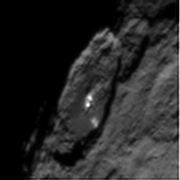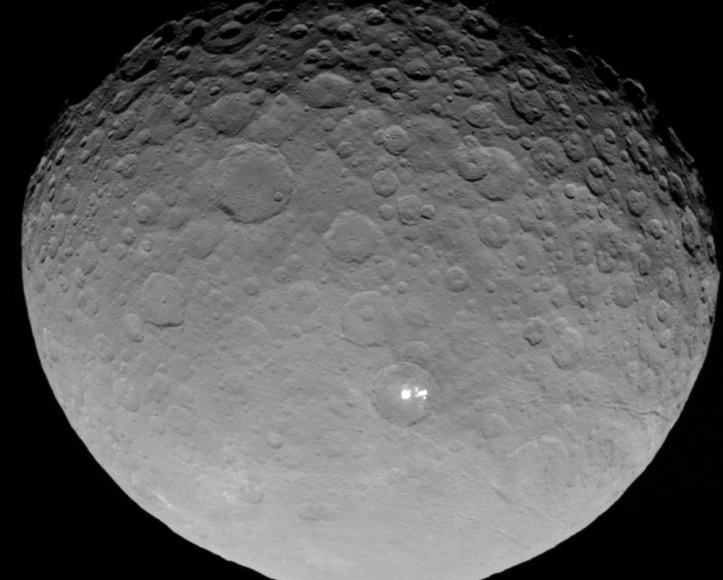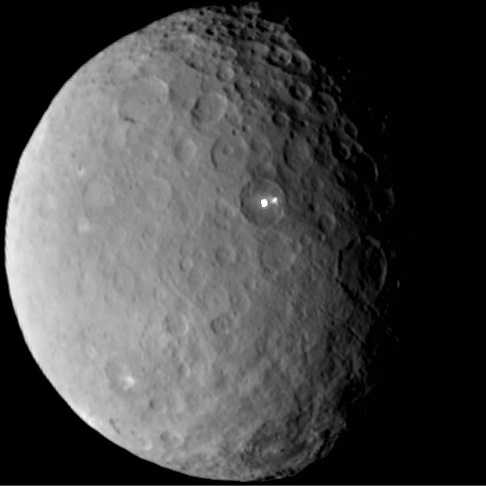It looks like you're using an Ad Blocker.
Please white-list or disable AboveTopSecret.com in your ad-blocking tool.
Thank you.
Some features of ATS will be disabled while you continue to use an ad-blocker.
share:
a reply to: admirethedistance
I know I'm tardy to the party, but who's going to look more foolish? Someone who took a chance and imagined something extraordinary (That you can't prove to be false right now)? Or the person who went out of his way to shoot him down?
Anyway, regarding the original post: I really do hope this is some sort of 'contact'...It really does look like lights of some sort (especially compared to the images of lights from Earth). The Ceres lights just aren't as sporadic and spread out; They're just clumped together...
At this point it really could be anything. I hope OP is right though. Thanks for sharing!
I know I'm tardy to the party, but who's going to look more foolish? Someone who took a chance and imagined something extraordinary (That you can't prove to be false right now)? Or the person who went out of his way to shoot him down?
Anyway, regarding the original post: I really do hope this is some sort of 'contact'...It really does look like lights of some sort (especially compared to the images of lights from Earth). The Ceres lights just aren't as sporadic and spread out; They're just clumped together...
At this point it really could be anything. I hope OP is right though. Thanks for sharing!
edit on 7/15/2015 by mysticrecluse because: Edit to
add relevant stuff...
a reply to: mysticrecluse
I'd say the person who automatically jumped to the most unlikely conclusion, without any evidence to support that position.
I'd say the person who automatically jumped to the most unlikely conclusion, without any evidence to support that position.
Don't know how it could be a city. That just doesn't make sense (due to the lack of infrastructure around it, lack of power, food, etc etc..) - could
very well just be a phenomena we are not familiar with, or an element or something along those lines.
I imagine there are countless natural phenomena, elements, and so on that we have no clue about. Just because it resembles city lights at night on our planet, hardly becomes evidence that there is a solitary alien city in a crater with no other evidence of life at all other than "It's bright."
I imagine there are countless natural phenomena, elements, and so on that we have no clue about. Just because it resembles city lights at night on our planet, hardly becomes evidence that there is a solitary alien city in a crater with no other evidence of life at all other than "It's bright."
a reply to: funbox
No idea but it's spinning on its axis one way while rotating counter clockwise. Or sumthin
But because of this, light source from two different areas, shouldn't make it as bright as it is I would think
No idea but it's spinning on its axis one way while rotating counter clockwise. Or sumthin
But because of this, light source from two different areas, shouldn't make it as bright as it is I would think
edit on 15-7-2015 by FlySolo
because: (no reason given)
originally posted by: FlySolo
a reply to: spirit_horse
Here's one more thing to think about:
Both pictures
- same rotation counter clockwise.
- same location of dawn (give or take)
- same light intensity
What's different?
Well, intensity is the same, even though it is entering the beginning of the shadow which I would call sunset. I consider the terminator to be when it go into dark with no light.
Here is a zoomed photo from the Ceres Mission page...

Source
It is interesting in that the spots to the right are slightly dimmer. It looks like a complex structure, but 1 pixel =1,400ft.
I am waiting until it gets to lower orbits and see what we can see then.
ETA: I do notice the smaller dots seem to be gone or not shining around the second spot to the right in the lower photo, which would seem to be loss of light confirming a reflection theory. Assuming the same resolution.
edit on 15/7/15 by spirit_horse because: (no reason given)
a reply to: spirit_horse
Ah well now that completely mucks things up! wtf? The fact the second group of lights are dimmer while in such close proximity, kind of shoots holes in the reflection theory no?
eta: the light source position is different
It is interesting in that the spots to the right are slightly dimmer.
Ah well now that completely mucks things up! wtf? The fact the second group of lights are dimmer while in such close proximity, kind of shoots holes in the reflection theory no?
eta: the light source position is different
edit on 15-7-2015 by FlySolo because: (no reason given)
a reply to: admirethedistance
Fair enough, but OP does have evidence though. There are pictures of lights on Earth. It just takes some extra effort to put two and two together, and use the images as evidence...and maybe even think outside the box for a second. (These comparative images are not proof, but evidence? Yeah. I'd consider them pretty decent evidence)
Is it really so terrible to consider the possibility of alien life so close to home?
Fair enough, but OP does have evidence though. There are pictures of lights on Earth. It just takes some extra effort to put two and two together, and use the images as evidence...and maybe even think outside the box for a second. (These comparative images are not proof, but evidence? Yeah. I'd consider them pretty decent evidence)
Is it really so terrible to consider the possibility of alien life so close to home?
Hello!
Regarding:
Here is a zoomed photo from the Ceres Mission page...

Source
It is interesting in that the spots to the right are slightly dimmer. It looks like a complex structure, but 1 pixel =1,400ft.
I noticed, then went back and checked the few other zoomed-in images.
I can't help but notice a U shaped "photoshop smear" around the brightest spot, to the "south".
If you look carefully you can distinguish a few details below the smear., like two radial ligter rays going at 6 and 7 o'clock.
Cheers
Ari
Regarding:
Here is a zoomed photo from the Ceres Mission page...

Source
It is interesting in that the spots to the right are slightly dimmer. It looks like a complex structure, but 1 pixel =1,400ft.
I noticed, then went back and checked the few other zoomed-in images.
I can't help but notice a U shaped "photoshop smear" around the brightest spot, to the "south".
If you look carefully you can distinguish a few details below the smear., like two radial ligter rays going at 6 and 7 o'clock.
Cheers
Ari
originally posted by: FlySolo
a reply to: spirit_horse
Ah well now that completely mucks things up! wtf? The fact the second group of lights are dimmer while in such close proximity, kind of shoots holes in the reflection theory no?
eta: the light source position is different
Perhaps, but if the elevation is different as in the left spot is higher than the right spots, then they could be getting dimmer due to loss of light from a shadow cast by the crater wall. The left spot may actually be higher than the crater wall. I think that is why NASA still says it is mysterious and they are not sure. A closer orbit should reduce the size per pixel and give more detail. Thing is, NASA usually tells us what things are (like atmospheric gases, composition, etc.) through telescopes. They do have other sensors besides the cameras on DAWN and still are not sure what they are or consist of. It is perplexing. Of course to keep the alien theory alive, they could have light dimmers lol!
Here is something to ponder. If they use bodies like this for underground bases to provide protection from asteroids, etc. then they may have technology like plasma fields to protect the entrance from cosmic radiation. We have considered plasma shields on spacecraft to do this. I have not read in depth on our technology theory of doing so, but it is a possibility that an advanced civilization could use normally. We are going out on a limb with any discussion along those lines though. Again at this point, as NASA says, "The bright spots on Ceres are still a mystery".
edit on 15/7/15 by spirit_horse because: (no reason given)
i.dailymail.co.uk...
This image for example, has very good detail all over except around the bright spots...
This image for example, has very good detail all over except around the bright spots...
originally posted by: arit_
Hello!
Regarding:
Here is a zoomed photo from the Ceres Mission page...
Source
I noticed, then went back and checked the few other zoomed-in images.
I can't help but notice a U shaped "photoshop smear" around the brightest spot, to the "south".
If you look carefully you can distinguish a few details below the smear., like two radial ligter rays going at 6 and 7 o'clock.
Do realize I zoomed the photo in Photoshop and as a result the square pixelation is showing more. It does look more complex, which is why I really want to see photos from a closer orbit to reduce the pixelation for better analysis.
edit on 15/7/15 by spirit_horse because: (no reason given)
a reply to: admirethedistance
I agree. The personal wish of alien life fights its way to the front of the realistic explanation line and flies past the things in which it could, and probably is, like mineral deposits of all shapes, sizes, etc.
It's a crater --in which things gather from a multitude of reasons and could leave other things behind that illuminate from this type of camera lens, or whatever.
Wherever that asteroid came from that made that crater, obviously left something behind that was imprinted within the sands, buried perhaps for a time, and is heavier, or was deeper and therefore has endured the disintegration of said asteroid, perhaps because how deep it is, being protected by walls on all sides --who knows.
It's not a city. It's not lights.
I agree. The personal wish of alien life fights its way to the front of the realistic explanation line and flies past the things in which it could, and probably is, like mineral deposits of all shapes, sizes, etc.
It's a crater --in which things gather from a multitude of reasons and could leave other things behind that illuminate from this type of camera lens, or whatever.
Wherever that asteroid came from that made that crater, obviously left something behind that was imprinted within the sands, buried perhaps for a time, and is heavier, or was deeper and therefore has endured the disintegration of said asteroid, perhaps because how deep it is, being protected by walls on all sides --who knows.
It's not a city. It's not lights.
originally posted by: fleabit
Don't know how it could be a city. That just doesn't make sense (due to the lack of infrastructure around it, lack of power, food, etc etc..) - could very well just be a phenomena we are not familiar with, or an element or something along those lines.
I imagine there are countless natural phenomena, elements, and so on that we have no clue about. Just because it resembles city lights at night on our planet, hardly becomes evidence that there is a solitary alien city in a crater with no other evidence of life at all other than "It's bright."
So, you would expect power plants, crops or Mc Donalds around? There is evidence the moon is mostly hollow (Earths). If I were visiting or moving into a planet, then being inside or deep under water would be a good idea. For example, Earth's weather with lightning, cyclones, tornadoes, asteroid impacts, etc. is a dangerous place to be. Living inside a rock like Ceres would be good to prevent cosmic radiation, asteroid impacts, etc. If the place is just an entrance to an underground installation of some sort then I wouldn't expect to see any of the things you suggested. We do not know what an alien species would require or have that differs greatly from us.
They may use Zero Point energy and not need power stations and grid infrastructure. They may know a very rare element is located inside that is worth mining. You just don't know what a super advanced civilization may look like or what their interests are. It could even be a military outpost of some type that protects a civilization elsewhere in the solar system we know nothing about. The possibilities are myriad, but to compare them to what you know or expect doesn't pass muster.
We will have to wait for closer more detailed pictures and analysis from the other sensors aboard DAWN to make a better determination. It could be anything, from ice, rare element we know nothing about surfacing through some other process, or an alien base. We just do not know at this point, so discussion of the possibilities are possible now. Later, they may not be as we will have better evidence.

I don't know what it is, but I do know it is very rare for a reflected light to have the same intensity while the angle between the observer and reflective surface and the light source changes.
Think of it like someone is holding a huge mirror a long distance away from you, and trying to use it to reflect sunlight into your eyes while you are riding a bike. For the intensity to remain constant while you move, the mirror will have to be moved as well.
The only other way it would happen is if it wasn't a large flat surface like a mirror, but a collection of many tiny little sphere shaped mirrors. That way no matter what angle you move to, the mirror is at the correct angle and would not have to move. Perhaps a diamond like substance with many tiny different flat surfaces at many different angles could do the trick too, but that would be less stable of a reflection as you move.
In my opinion, it does look self-illuminated. Weird.
edit on 15-7-2015 by WeAre0ne because: (no reason given)
a reply to: WeAre0ne
Right we can't discount that it's some sort of giant crystal formation. Maybe that has millions of facets reflecting light in every direction.
Or that it's a natural light source.
Or that it's a non natural light source.
Either way we will see.
Right we can't discount that it's some sort of giant crystal formation. Maybe that has millions of facets reflecting light in every direction.
Or that it's a natural light source.
Or that it's a non natural light source.
Either way we will see.
edit on 15-7-2015 by grey580 because: (no reason given)
Here is a zoom of the photo linked by arit_

Still an interesting structure whatever it is.
ETA: It seems to have diffracted light around the bright spots.

Still an interesting structure whatever it is.
ETA: It seems to have diffracted light around the bright spots.
edit on 15/7/15 by spirit_horse because: (no reason given)
new topics
-
Potter to WHU
World Sports: 1 hours ago -
Dr. Demento
Music: 3 hours ago -
The elephant in the room (wearing a hoodie)
US Political Madness: 3 hours ago -
To become president, Zelensky had to learn Ukrainian
Political Conspiracies: 9 hours ago
top topics
-
Green Grapes
General Chit Chat: 13 hours ago, 6 flags -
To become president, Zelensky had to learn Ukrainian
Political Conspiracies: 9 hours ago, 6 flags -
The elephant in the room (wearing a hoodie)
US Political Madness: 3 hours ago, 6 flags -
Dr. Demento
Music: 3 hours ago, 2 flags -
Potter to WHU
World Sports: 1 hours ago, 1 flags
active topics
-
Los Angeles brush fires latest: 2 blazes threaten structures, prompt evacuations
Mainstream News • 127 • : Xtrozero -
To become president, Zelensky had to learn Ukrainian
Political Conspiracies • 14 • : Imhere -
The elephant in the room (wearing a hoodie)
US Political Madness • 11 • : Xtrozero -
Post A Funny (T&C Friendly) Pic Part IV: The LOL awakens!
General Chit Chat • 8005 • : baddmove -
Planned Civil War In Britain May Be Triggered Soon
Social Issues and Civil Unrest • 28 • : BedevereTheWise -
Dr. Demento
Music • 5 • : CyberianKhatru23 -
My personal experiences and understanding of orbs
Aliens and UFOs • 40 • : ufoorbhunter -
Trump says ownership of Greenland 'is an absolute necessity'
Other Current Events • 67 • : xuenchen -
Steering the Titantic from the Drydock.
Rant • 45 • : Freeborn -
Potter to WHU
World Sports • 1 • : gortex


